The story of lost gold has been an enduring staple of literature and film since Robert Louis Stevenson penned Treasure Island in 1883. A car locked away in a barn, or, as likely in the UK, a garage, is also a story of lost treasure in a cave. But how did those steel and aluminium beauties get into those barns? It’s a thought that continually runs through my head when undertaking barn finds for our show, Barn Find Hunter.
In the good old days, people bought cars to match a specific period in their lives. When life changed, when the surfer got a real job and needed reliable wheels, the woody wagon was often sold. But sometimes, that person would stow a car in the back of a garage or barn, or out in the back 40, leaving it to rot in the elements while the owner got on with life, occasionally giving a thought to fixing up the old ride. Of course, hoarding plays a role. Some folks can’t let go of anything, and they collect cars the way others stack up old newspapers around the house. I’ve seen Ferraris and Cobras and Gullwings suffer that fate, but most of the time, it’s a Falcon or a Corvair or a Mustang. Passersby might notice them tucked away in garages and carports, might even knock on the door to see if they’re for sale, but they almost never are. An old, neglected car is a metal daydream with a physical presence. It sits there reminding you of that massive obligation you’ve made to someday pull out the tools and get the project done. For some people, to sell the car is to realise they’ve failed, that youth somehow became middle age that somehow became twilight, and still the car sits, a relic from a long-lost adolescence. And that’s a tough thing to swallow.

This is why so many people go to their graves without having sold off their cars. At least they are leaving with their chins high. It wasn’t laziness or a shortage of desire to finish the car, just a shortage of time. But the cars live on, and I’m always looking for the next one.
The Vette in the Shed
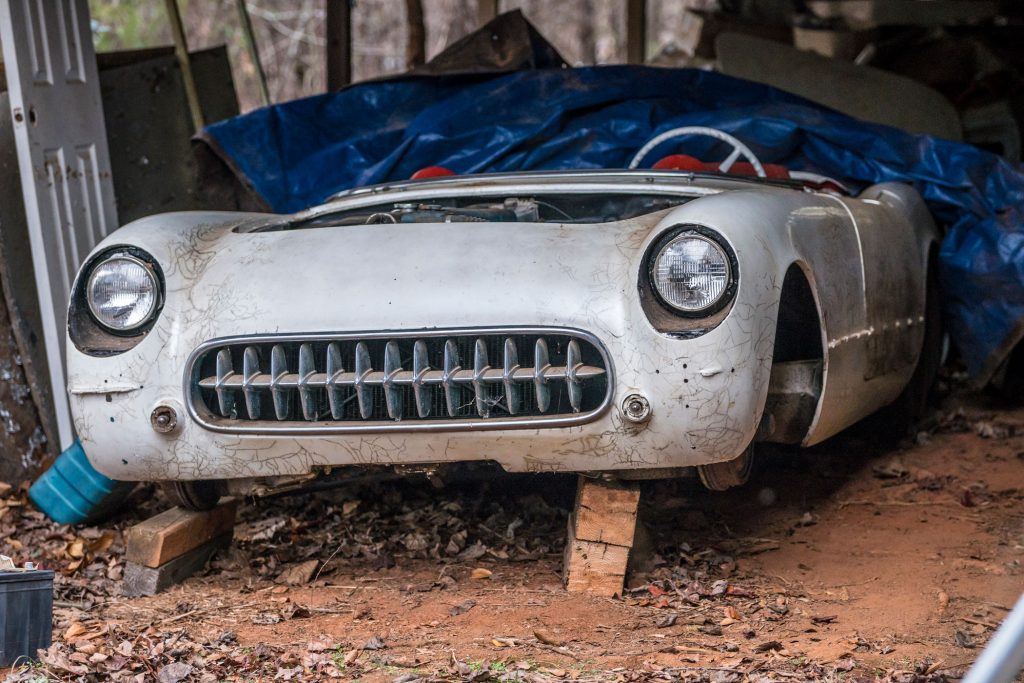
Dean owns a used-car lot filled with shiny convertibles and SUVs but told me he had lots of interesting cars a few miles away. I agreed to meet him at closing time so we could take a look at his collection.
I followed Dean seemingly miles on dirt roads until we arrived at his stash. Dozens of cars were scattered throughout the woods, the nicer ones in homemade carports and lean-tos, but most were out in the elements. A big-block Chevelle here, an old Datsun 240Z over there. I was attracted to a Rambler Marlin with a V8 and a four-speed transmission. “It runs” was all he said.
“Take a look under that shed,” Dean told me, pointing to cars that were protected from the elements but dirty from decades of windblown north Georgia sand. I saw a big-block Impala convertible, a Mopar wagon, and more Chevelles. But among all the uncovered, dusty cars was some sporty thing covered with a black plastic sheet.
“You’ll like this one,” he said, as he began to lift the cover.
“No, please don’t,” I said. “I’d like to try to identify this car by feeling through the cover.”
“Good luck,” Dean said, preparing to be humoured by my abstract guesses.
I started at the front and felt a toothy grille. The headlights, one on each side, were recessed into cavities. I could feel that the hood was missing, as was the windshield. In the rear were round taillights surrounded by little fins.
“I don’t believe it, but I’d say this is a first-generation Corvette,” I said.
“You’re right,” he said, clearly amused that my first guess was correct.
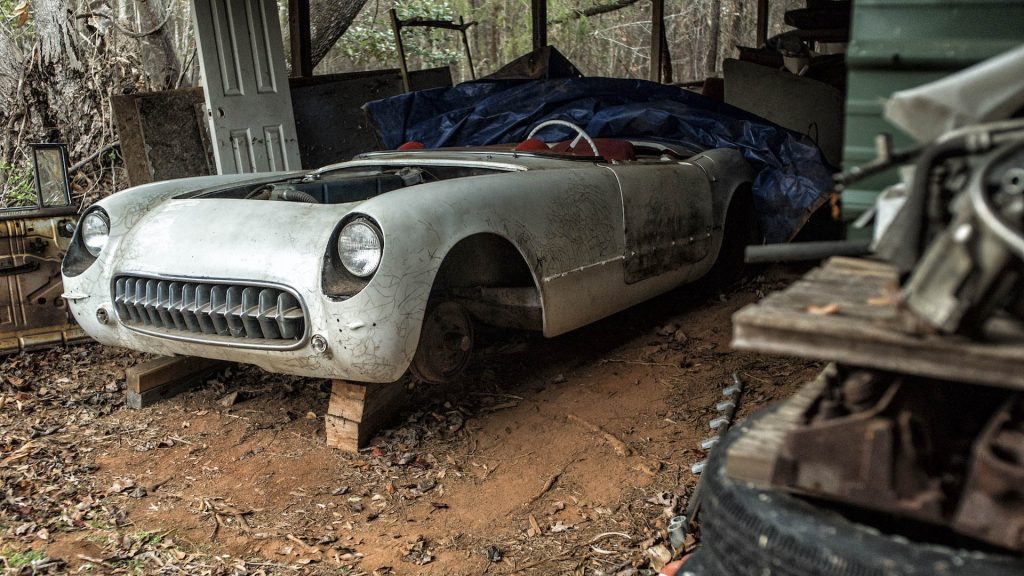
He pulled off the cover, and son of a gun, there sat a correct, white-with-red-interior 1954 Corvette. This was one of the more significant discoveries of my lifelong barn-finding career. This was the second year of Corvette production, when 3640 were built, or 3340 more than the year before, using mostly off-the-shelf mechanical bits sourced from Chevrolet’s sedan line.
A Blue Flame straight-six engine with three Rochester single-barrel side-draft carburetors sat in the engine compartment. The correct Powerglide two-speed automatic transmission was mounted behind. It would be another two years before consumers could order a manual transmission in a Corvette.
The hood and the windshield sat behind the car, so this Corvette was complete and original. It was an amazing discovery, especially considering that thousands of commuters on I-85 pass within 100 yards of this shed every day.
In my head I began to scheme about buying the car, putting it together, and enjoying it as is. Dean quickly put the kibosh on that plan. “I’m not ready to sell it,” he said. “I’ve had it a long time, and it means a lot to me. I’d rather sell a few of the other cars and then restore this one.”
So I helped Dean cover the Corvette again and said goodbye. I couldn’t help thinking I might be the last person to see this car for years, even decades, as it continues to hibernate in this lonely shed in the woods by the interstate. But that’s often the way with barn finds.
Big-block mouse motel
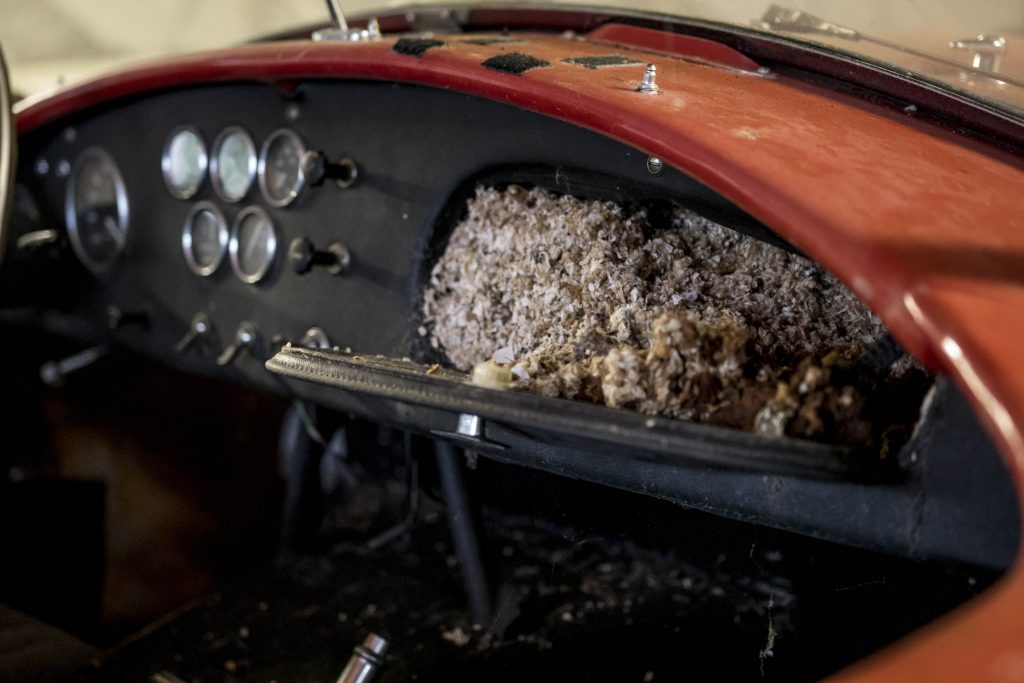
I was contacted by Warren, who had an amazing story. His friend Alan owned a few unique cars that needed to be moved quickly. “Alan owns a house that has been condemned by the city,” Warren said. “It’s slated to be demolished in a few weeks. Commercial towing companies won’t haul the cars because of their value. Do you think you can help me move them?”
I had nothing pressing scheduled for the next couple of weeks, so I agreed to meet Warren 20 miles from where I lived. The neighbourhood had elegant homes with beautiful lawns and professional landscaping – except Alan’s house. As I pulled into the driveway, I realised this home hadn’t been lived in for a long time. Tree limbs and bushes partly blocked the moss-covered pavement. Making my way to the backyard garage, I saw mould and mildew on the house’s wood cladding. Warren was waiting next to the garage, relieved that someone would help him move its contents. As he raised the garage door, I was bombarded with musty air. And crickets. It was dark, but I could make out the flowing shape of a red sports car.
Could it be a Cobra? I’d been waiting my whole life for a moment like this. Warren confirmed that his friend once had a penchant for exotic sports cars, but at some point, Alan parked the cars and shut the door. As my eyes adjusted to the dank environment, I could see that this garage was something of a tropical rain forest, with branches and weeds coming through a broken window and spider webs everywhere.
“The Cobra hasn’t been driven in 40 years,” Warren said, “but the city will demolish the house and garage before the new year, so all the cars need to be moved soon.”
Ignoring the five other cars in the building, I concentrated on the Cobra. It was red and had big, beautiful wings. It was obviously a big-block, or what we call a 427. Its elegant bodywork had a layer of dust, spider webs, and wood debris from the rotting timbers above.
I opened the hood. By the serial plate on the passenger-side foot box, I noted that the CSX Mark III chassis number meant it was not actually built with a 427-cubic-inch (7-litre) engine, but in fact with the slightly less powerful but ultimately more drivable 428-cubic-inch Police Interceptor engine. In an effort to earn more profit, builder Carroll Shelby saved a couple hundred dollars per car by installing an engine with about 30 fewer horsepower.
Although horses had once lived under the hood, the trunk now contained evidence of a different type of animal: mice. A virtual rodent condo covered most of the spare tire and the fiberglass trunk floor. And if the trunk was where Mr. and Mrs. Mouse had lived, the glove box, four feet away, was where they vacationed. Both were filled with several inches of tangled thread, pillow stuffing, small pieces of wood, and the especially rank odour that only comes from decades of rodent habitation.
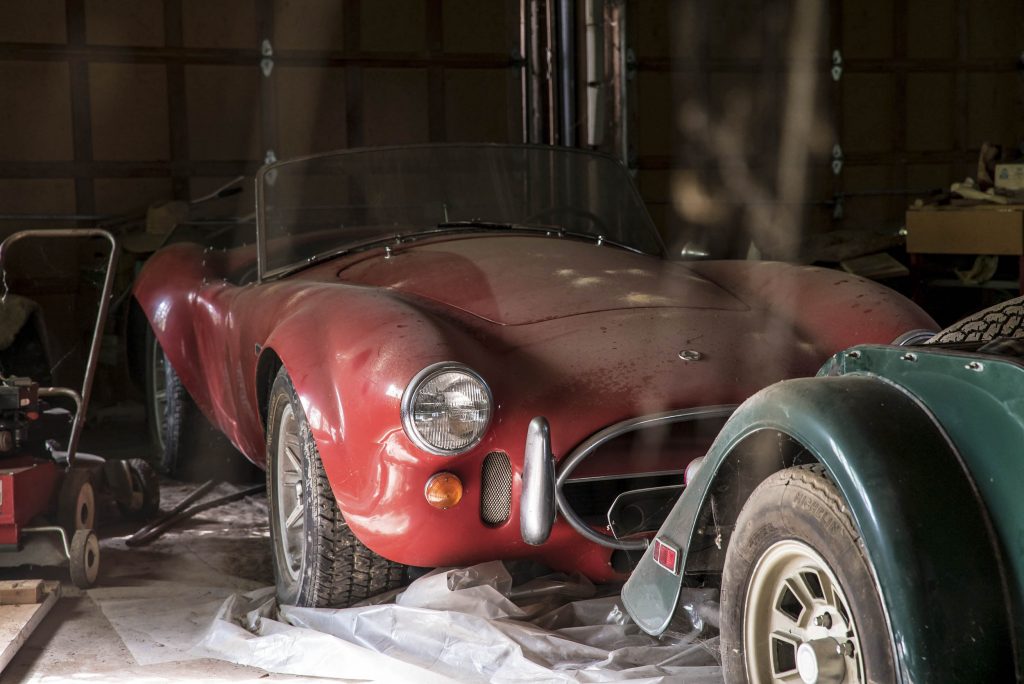
But it was a genuine Cobra, the fantasy vehicle of many barn-find hunters. It finally escaped its grungy prison for the auction block, trading hands at Amelia Island, in March 2017, for $1,045,000. The well-known Cobra collector who bought it was prepared to pay $1.3 million and told me, “I got the deal of the weekend!” It has since been cleaned up and today, still in original paint, looks absolutely beautiful.
Alloy-body abuse
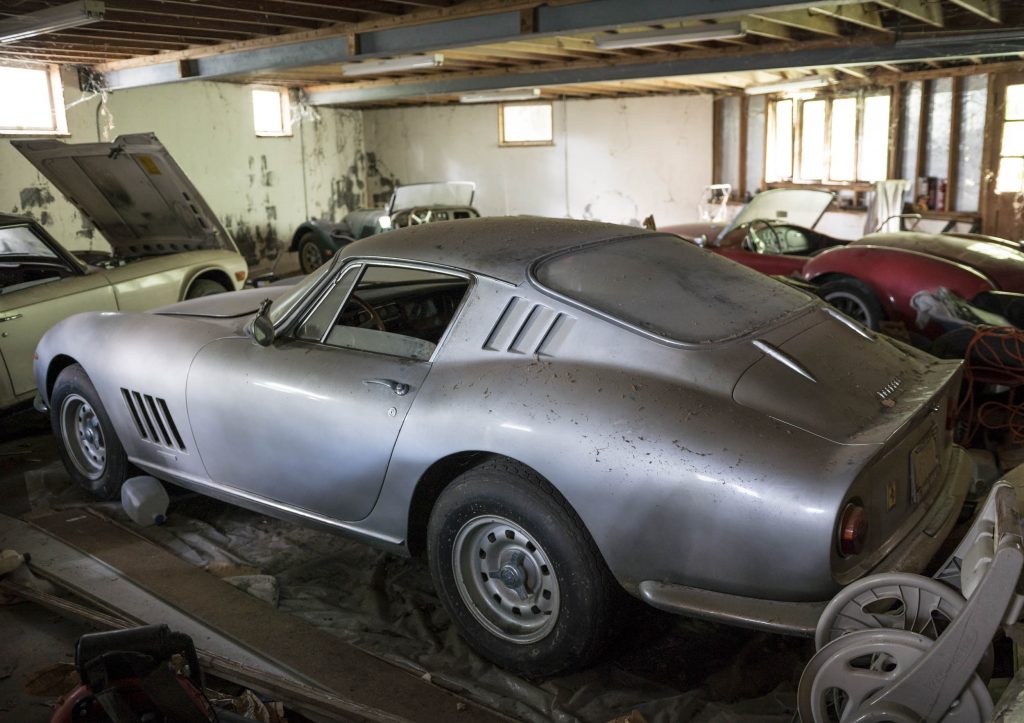
You can buy and totally abuse a car and still make money – if you buy the right car. Case in point: this Ferrari, a 1966 275GTB, sold in excellent condition in the early 1980s for the then market value of $47,000. The car had a couple of features that separated it from similar, garden-variety Ferraris. Instead of being constructed of steel, its coachwork was aluminium alloy. It had an extended nose that allowed the front end to remain stable on long racing straightaways such as the Mulsanne Straight at Le Mans. When new, this car could have been driven to the track, raced, and, barring disaster, driven home again.
The third owner sold the car almost 40 years ago. The fourth drove it occasionally and had it lovingly serviced by a Ferrari mechanic. But when that mechanic tragically died in a motorcycle accident, the Ferrari’s owner parked the car in his “new” garage, shut the door, and forgot about it for decades. This rare 275GTB – one of 80 with the aluminium body – had just 13,000 kilometres on the clock.
That new garage kept the Ferrari in sound condition for the first few years, but then the wood on the north-facing wall began to rot. Small holes in the wall allowed rodents, crickets, and other insects to enter the garage and thus the Ferrari. Branches and vines from nearby trees infiltrated the garage. Spiders spread their webs over that fabulous silver alloy body. Whenever the wind blew, the Ferrari was exposed to the filth from the ever-enlarging holes in the wall. Crud fell from the ceiling, the result of slowly rotting ceiling timbers. Fortunately, nothing that fell was large or heavy enough to dent the fragile alloy bodywork.
Since the windows were left partly open, the navy blue interior became covered with dust, dirt, and cobwebs. As I inspected the car, my trousers accidentally brushed up against the bodywork. Filth seemed to jump off the car and onto my clothes. Same thing with the interior. When I sat in the driver’s bucket to inspect the odometer, yuck attached itself to me. Those darn spider webs were in my hair. Surely, I’d have to take a shower this month.
Opening the trunk revealed contents that had been in solitary confinement. The trunk mat, the spare tire, and the jack were pretty clean. But the best part was when I unrolled the factory tool bag, which revealed practically brand-new contents. The shiny “made in Italy” wrenches, pliers, screwdriver, and hammer had probably not been exposed to daylight since the car was new. At least one part of this low-mileage car was in concours condition.
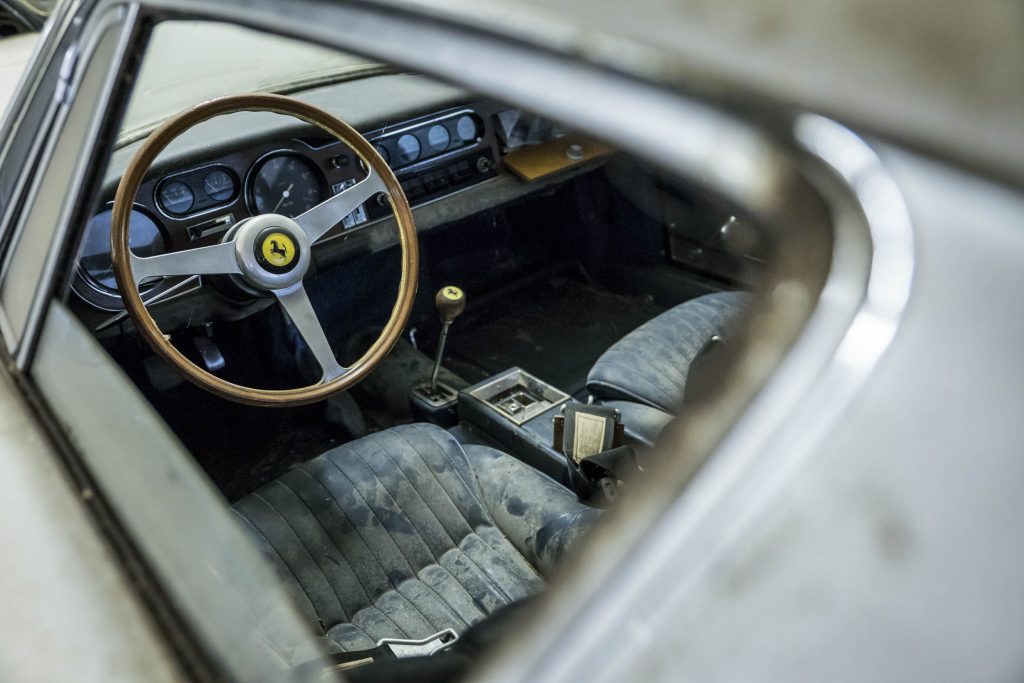
The owner decided to take the car to the Gooding & Company auction at Amelia Island in Florida. Since barn-find automobiles seem to be all the rage these days, Gooding decided to keep the car in as-discovered condition when it was driven on stage. Bidding started high and was brisk, easily passing $1 million dollars, then one-and-a-half, then two million. At the end of bidding, the car cost its new owner more than $2.5 million. That’s a profit more than 50 times the owner’s original purchase price of $47,000, despite decades of abuse.
Not a bad return on investment. Just don’t try that with your MGB.
Quarter-century slumber Jag
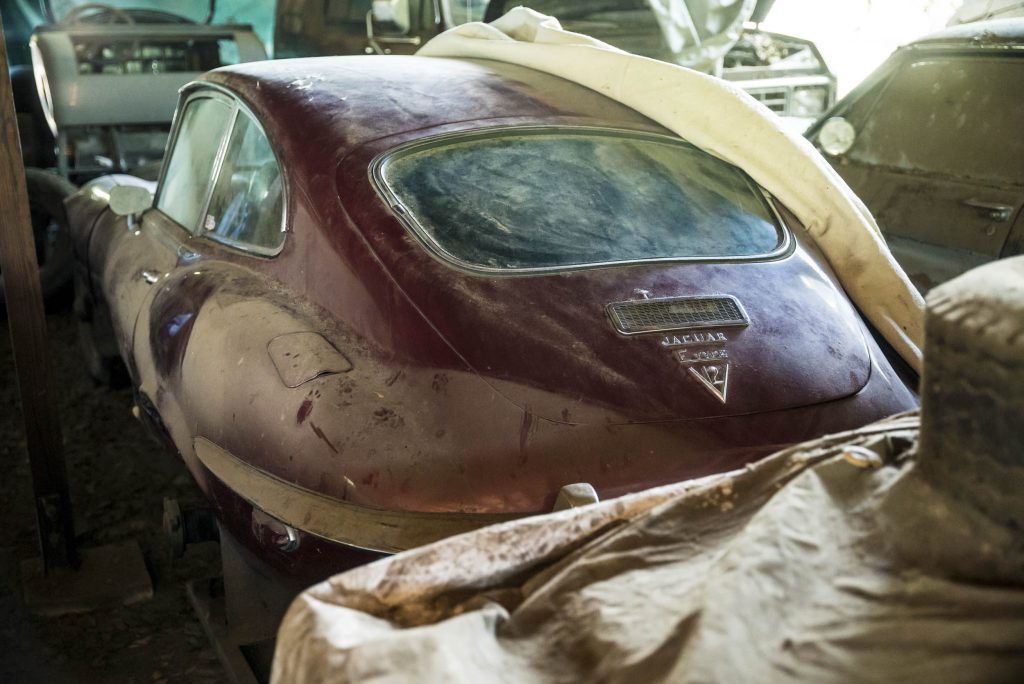
Lifting dusty car covers to inspect the vehicles beneath can be a longer process than I had thought possible. A few hours earlier, I knew nothing of Dwayne and his car collection, but now I realised I’d probably spend the rest of the day in his many sheds lifting covers.
It was a lead we’d picked up from Shelby, the appropriately named proprietor of a restoration shop near Ojai, California. Shelby gave me Dwayne’s phone number. I called, and luckily, Dwayne said I was welcome to see his car collection. The beauty of Dwayne’s collection is that the cars are in as-driven condition, not restored to concours standards.
These cars wouldn’t have those irritating “Unless You’re Naked, Please Don’t Touch Me” decals. You see, Dwayne is not only an enthusiast and collector but also a businessman. He rents his cars to Hollywood film houses for use in movies. Most of the cars he has were purchased when they had no real collector value. He bought them because he liked them, they were cheap, and occasionally he made income from them. He showed us a vintage tow truck that was sent to Cuba for The Fate of the Furious.
One of the cars that caught my attention was a burgundy Jaguar E-type coupe. Sitting like a caged animal, a prisoner of a small barn, this Jag was landlocked among Buick station wagons, Ford tractors, and a Cadillac Biarritz convertible. By the accumulated dust on the canvas cover, this car had been here for a long, long time.
I asked Dwayne about it. “Gosh, I bought that car in the mid-’70s,” he said. “It was totaled.” Dwayne bought it from an independent Jaguar repair shop in Ventura, California. The car had smacked a bridge abutment with such force that the owner of the repair shop wanted to sell it for parts. “It was hit so hard that the exhaust manifold on the driver’s side cracked from the impact,” he said. “Even though it was only a couple of years old, I paid very little for it. I was convinced it could be fixed.”
Dwayne persuaded the shop owner to help him repair the car. When it was completed, it was a gem. With a V12 engine and four-speed manual gearbox, this coupe is rare, and it suited Dwayne’s lifestyle.
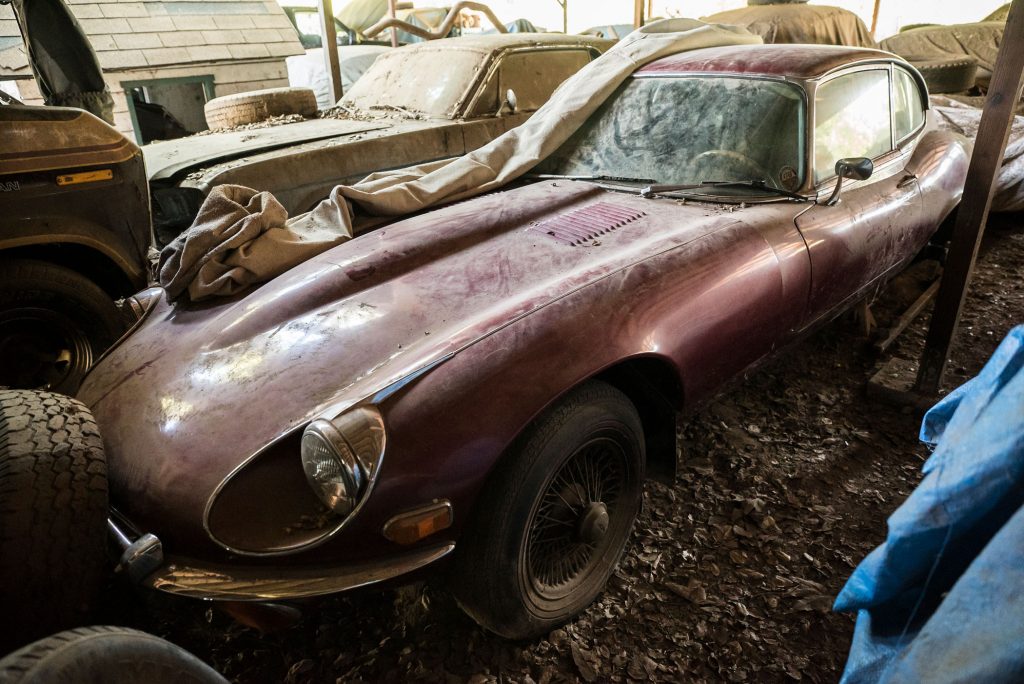
“We drove it a lot when my kids were small,” he said. “We’d drive it to San Diego and San Francisco all the time. I have a logbook with the fuel mileage. Around town it got about 10 miles per gallon, but on the highway it got as high as 15.”
Dwayne showed me a photo of his daughter, Cambria, next to the Jaguar when she was about a year and a half old. Today, she’s a school teacher.
As time went on, Dwayne made new acquisitions.
The Jag was parked in the shed and covered in 1993. Before I lifted that cover, it might have been a decade or two since anyone had inspected the car.
I had to ask: “Is it for sale?”
“I’m not really a collector,” he said, “but I’ve never sold a car. I still have the 1929 Packard my father gave me when I was 12.”
Without actually telling me no, I knew what his answer was.
Rocky-mountain-high Porsche
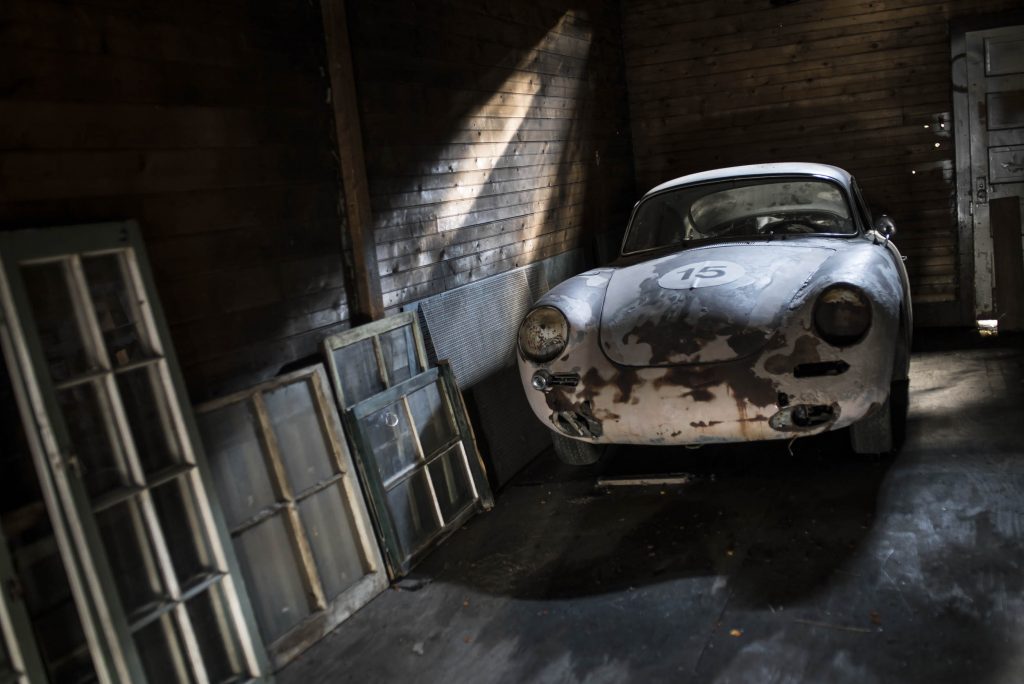
Bruce is into old stuff. He runs an antique shop on Main Street in Leadville, Colorado. His establishment is stuffed to the rafters with cool bric-a-brac. He has shelves of old cameras, tools, and vintage household items. But I hadn’t driven several hours from Denver to see household items. I’d driven here because I was told Bruce has old sports cars he has dragged home from throughout the Rocky Mountain State.
Leadville is a former mining town high in the mountains. At 10,152 feet above sea level – nearly two miles – it is the highest-altitude city in the United States. Travellers, like me, coming from sea-level states often have a problem breathing. The altitude made me feel like I had a sinus infection. My nose wouldn’t stop running, but I was more than a mile from the nearest tissue.
As tough as it is for a sea leveler like me to adjust to the thin air, Leadville is the site of one of the most challenging human endurance contests on earth: the Leadville 100. Since 1983, world-class athletes annually compete here in a 100-mile ultra-marathon on remote mountain passes at elevations ranging from 9200 feet to more than 12,000.
For the rest of us, Leadville is a tough place to survive. For old cars, however, the environment is just right. The air is dry, and even though it snows, the snow is powdery. Because salt is not used on winter roads, cars in this region are usually pretty well preserved.
Bruce took us to a couple of old garages and showed us cars he had dragged in over the years. A Karmann Ghia here, an old Formula Ford race car there. But sitting in a building all by itself was this wonderful Porsche 356C.
“I’ve owned it since 1982,” he said. “The local UPS driver asked me one day if I was interested in an old Porsche. He said, ‘It’s lying out in a field a few miles from here.’ So I followed his directions, and this Porsche followed me home.” The car was covered in surface rust but appeared to be fairly solid.
“It has a little bit of rust, and it has had a front fender grafted on, like they all have, but it’s pretty solid.” Bruce is the third owner. The original owner was an American stationed in Germany who bought it in 1965. “He smashed the front end and attempted to repair it himself,” said Bruce. “But he never finished it, and it just sat.”
That coating of rust hides the original Dolphin Grey, which is a light blue. The interior was originally dark blue. Even though the Porsche has never been raced, Bruce couldn’t restrain himself from applying a racing number on the hood. It has only been driven 67,000 miles from new, and the optional Blaupunkt radio still resides in the dashboard.
Bruce has never started the engine, but he regularly turns it over by hand.
“I think it would run without too much effort,” he said. When I asked him if he’d consider selling it, he thought about it for a moment. “I have a lot of cars and can’t restore all of them. I’d let this one go.”
Hangar-find hardtop
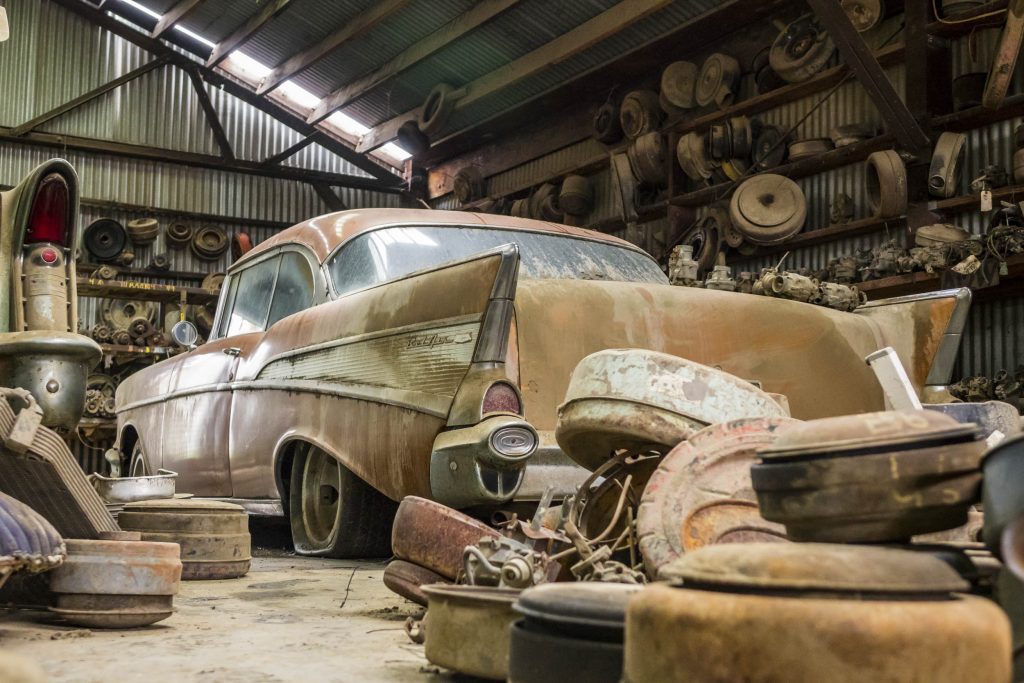
I had been driving around northern California looking for old cars for a few days. As always, I asked car enthusiasts to give me leads on other cars they knew about. I was told about Turner’s Auto Wrecking in Fresno. “Fresno,” I thought to myself, “that’s too far away.” It was more than 200 miles from St. Helena. But when I used Google Earth to spy on Turner’s from a satellite, I knew I had to make the trip.
Four hours later, I drove into one of the largest auto salvage yards I had ever seen: 70 acres and more than 10,000 cars dating to 1928. This was similar to the yards my father and I haunted when I was a kid and we were scrounging for woody parts. Only this yard was much larger.
“You can go anywhere you want,” said proprietor Jerry Turner. “We’ve got cars on both sides of the road.” From the parking lot I could see some buildings. I asked Jerry if I could go into those as well. “Sure. There are a few buildings, including two airplane hangars.”
He told me the wide concrete road running through the middle of the yard was once a runway where he took off and landed in his own airplane. Jerry grew up here in a house still located on the property. He convinced his father to give him a few acres of the family’s farmland to establish a salvage yard. Eventually, his junkyard took over almost all of the onetime farm.
For someone who has searched out interesting junkyards for most of his life, this one was a winner. There were rows and rows of mostly American cars – Mopars, Fords, and GM products, some from the 1930s and ’40s, but most from the 1950s and ’60s. Most of the cars sitting outdoors, many thousands, had been picked over and were now depleted parts cars or maybe potential rat rods. But there were sheds and carports strewn throughout the property that housed some tasty vehicles even I would have considered.
There was a drive-it-away 1965 Ford Galaxie two-door hardtop with 30,000 miles on the clock, a Jeepster with a Chevy V8 that only needed to be washed, and a Model T roadster pickup that looked like it should be entered in the Race of Gentlemen. But I found my favourite vehicle of the day in one of the hangars. Sitting next to Jerry’s long-retired Cessna, and surrounded by hundreds of four-barrel carburettors spread across the floor, was a 1957 Chevy two-door hardtop that appeared to have been sitting in this dusty, windblown hangar for decades.
The Bel Air was metallic copper in colour, and the body was as solid as a rock. The car sat on Ansen Sprint aluminium wheels that, along with Cragar S/Ss and Keystone Klassics, were the most popular accessory wheels of the day. I peered through the dusty windows and saw a button-tufted interior. I opened the door and saw the Powerglide automatic shifter mounted on the steering column. This car was a time capsule right out of an American Graffiti drive-in scene.
The lever to open the hood was easy to find, front and centre below the horizontal chrome trim. I silently hoped to find a high-performance Rochester fuel-injection unit or a factory two four-barrel carb setup mounted atop the intake manifold, but no. The engine was dirty and dusty. I had no way to check engine numbers, but I wouldn’t have been surprised if it still had the original 283-cubic-inch (4.6-litre) V8 installed 60 years earlier.
The drivetrain had never been modernised. Instead of an updated alternator, the original generator sat perched over the driver’s-side valve cover. This engine was obviously the lower-horsepower V8, with only a two-barrel carburettor installed on a cast-iron intake manifold. Regardless, this was a special car that I would gladly have taken home.
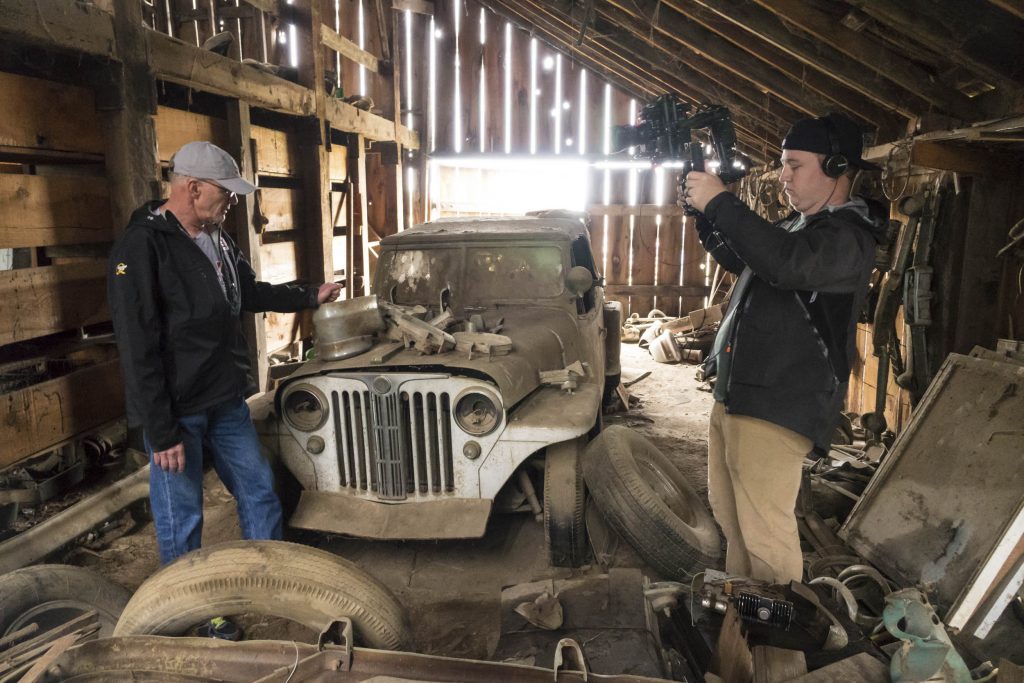
As I completed my tour of Turner’s yard and returned to the office, I had a few questions for the proprietor.
First, I asked about the Model T roadster pickup.
“Yeah, I’d take 25 for it,” said Jerry. As a barn finder, I never know how to handle an answer like that. Did he mean $25, $2500, or $25,000? I figured I’d shoot for the high number. “Twenty-five thousand is a lot of money for that truck,” I said.
“No, no, I meant $2500,” he said.
“Oh,” I said. “Does it run?”
“Sure does. I drove it in there 40 years ago,” he answered.
Okay, so it seems Jerry is not asking insanely high prices for his cars.
“How about the ’57 Chevy in the hangar?” I asked.
“Not for sale,” Jerry answered. “I gave it to my daughter years ago. I just wish she’d do something with it.”
So my favorite car was not for sale. Too bad. But my second favorite car was, for only $2500. But trying to thin out my garage at home, I decided to pass on the Model T. Besides, I was on strict orders from my wife, Pat: “No more cars.”
One thing was for sure: Jerry Turner was the nicest junkyard man I’ve ever met. He was friendly, willing to sell nearly everything, and his prices were reasonable.
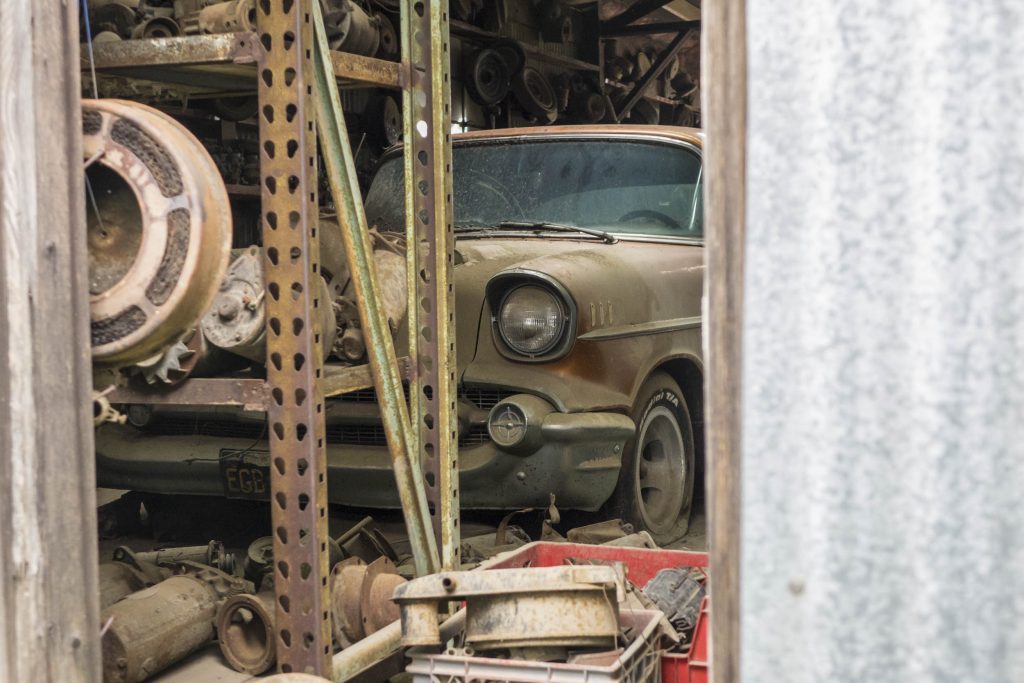
I said goodbye and drove back to northern California to search for more barn finds. When I returned home a few days later, I told Pat about Jerry Turner and his cars. I showed her photos of several of them, including the Model T.
“How much did he want for that?” she asked.
“$2500.”
“Why didn’t you buy it?”
Sometimes you can’t win for losing.
Editor’s note: This article was first published on Hagerty.com, in September, 2018. Tom Cotter is a treasure hunter who specialises unearthing rare and forgotten machines like Shelby Cobras and Ferraris that are, quite literally, treasures. In 2005, Cotter published his first book on automotive treasure hunting called The Cobra in the Barn. He hosts Hagerty’s hit series, Barn Find Hunter so we can all share in his moments of discovery. Barn Find Hunter is free to view on Hagerty’s YouTube channel.



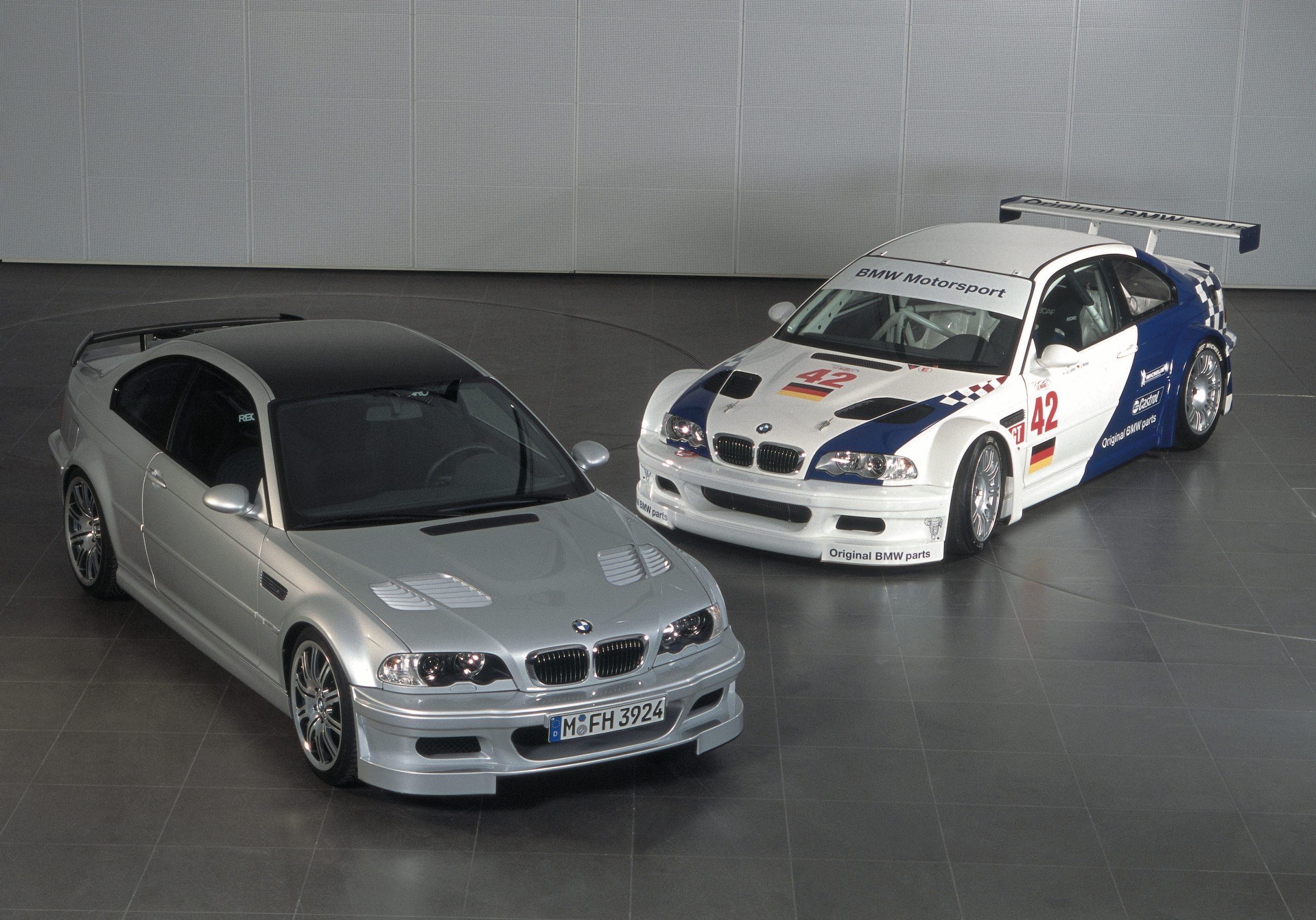





great story
Magical journey for me, especially the Cobra. At the finish period of my apprenticeship as a car painter I paint finished about 20 brand new seamless welded Cobra shells. Even got to drive the original V8 Prototype!. Loved it all, can you imagine the fun for an 18 year old. Rolling chassis’s were then dispatched to the Shelby base in USA for finishing and delivery. Such a beautiful and roguish set of wheels. Remember it as if yesterday.
Wonderful memories, Paul. We’d be really interested to talk with you in more detail about this. Please let us know if that’s of interest. Thanks. Ed.